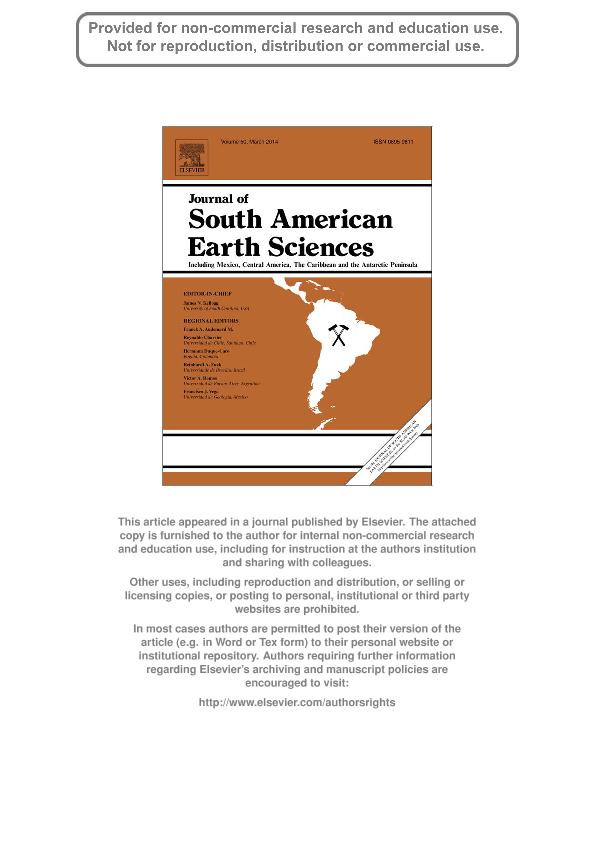Mostrar el registro sencillo del ítem
dc.contributor.author
Pagano Género, Diego Sebastián

dc.contributor.author
Galliski, Miguel Angel

dc.contributor.author
Marquez Zavalia, Maria Florencia

dc.date.available
2018-01-02T20:42:56Z
dc.date.issued
2014-01
dc.identifier.citation
Marquez Zavalia, Maria Florencia; Galliski, Miguel Angel; Pagano Género, Diego Sebastián; Emplacement of the La Peña alkaline igneous complex, Mendoza, Argentina (33° S): Implications for the early Miocene tectonic regime in the retroarc of the Andes; Elsevier; Journal of South American Earth Sciences; 50; 1-2014; 48-66
dc.identifier.issn
0895-9811
dc.identifier.uri
http://hdl.handle.net/11336/32045
dc.description.abstract
The La Peña alkaline complex (LPC) of Miocene age (18–19 Ma) lies on the eastern front of the Precordillera (32°41ʹ34ʺS, 68°59ʹ48″W, 1400–2900 m a.s.l.), 30 km northwest of Mendoza city, Argentina. It is a subcircular massif of 19 km2 and 5 km in diameter, intruded in the metasedimentary sequence of the Villavicencio Formation of Silurian-Devonian age. It is the result of integration of multiple pulses derived from one or more deep magma chambers, which form a suite of silicate rocks grouped into: a clinopyroxenite body, a central syenite facies with a large breccia zone at the contact with the clinopyroxenite, bodies of malignite, trachyte and syenite porphyry necks, and a system of radial and annular dikes of different compositions. Its subcircular geometry and dike system distribution are frequent features of intraplate plutons or plutons emplaced in post-orogenic settings. These morphostructural features characterize numerous alkaline complexes worldwide and denote the importance of magmatic pressures that cause doming with radial and annular fracturing, in a brittle country rock. However, in the LPC, the attitude of the internal fabric of plutonic and subvolcanic units and the preferential layout of dikes match the NW–SE extensional fractures widely distributed in the host rock. This feature indicates a strong tectonic control linked to the structure that facilitate space for emplacement, corresponding to the brittle shear zone parallel to the N–S stratigraphy of the country rock. Shearing produced a system of discontinuities, with a K fractal fracture pattern, given by the combination of Riedel (R), anti-Riedel (R′), (P) and extensional (T) fracture systems, responsible for the control of melt migration by the opening of various fracture branches, but particularly through the NW–SE (T) fractures. Five different pulses would have ascent, (1) an initial one from which cumulate clinopyroxenite was formed, (2) a phase of mafic composition represented by dikes cross-cutting the clinopyroxenite, (3) a malignite facies that causes a small breccia in the clinopyroxenite, (4) a central syenite facies that develops breccias at the contact with the clinopyroxenite and, finally, (5) porphyry necks and a system of radial dikes intruding all units. At the moment of the emplacement different mechanisms would have acted, they summarized in: 1) opening of discontinuities synchronous to the magma circulation as the principal mechanism for formation of dikes and conduits; 2) stoping processes, that play an important role in the development of the breccia zone and enabling an efficient transference of material during the emplacement of the syenitic magma and 3) shear-related deformation (regional stress), affected the internal fabric of the facies, causing intracrystalline deformation and submagmatic flow, which is very evident in the central syenite intrusive. The kinematic analysis of shear planes allows proposing that emplacement of the LPC took place in a transtensive regime, which would have occurred in the back-arc of the Andes orogen, during a long period spanning from Miocene to the present, of the compressive deformation responsible, westward and at the same latitude, for the development of the Aconcagua fold and thrust belt.
dc.format
application/pdf
dc.language.iso
eng
dc.publisher
Elsevier

dc.rights
info:eu-repo/semantics/openAccess
dc.rights.uri
https://creativecommons.org/licenses/by-nc-sa/2.5/ar/
dc.subject
Alkaline Complex
dc.subject
Miocene
dc.subject
Shear Zone
dc.subject
Transtensive Regime
dc.subject
Precordillera
dc.subject
Mendoza
dc.subject.classification
Meteorología y Ciencias Atmosféricas

dc.subject.classification
Ciencias de la Tierra y relacionadas con el Medio Ambiente

dc.subject.classification
CIENCIAS NATURALES Y EXACTAS

dc.title
Emplacement of the La Peña alkaline igneous complex, Mendoza, Argentina (33° S): Implications for the early Miocene tectonic regime in the retroarc of the Andes
dc.type
info:eu-repo/semantics/article
dc.type
info:ar-repo/semantics/artículo
dc.type
info:eu-repo/semantics/publishedVersion
dc.date.updated
2017-12-29T14:12:56Z
dc.journal.volume
50
dc.journal.pagination
48-66
dc.journal.pais
Países Bajos

dc.journal.ciudad
Ámsterdam
dc.description.fil
Fil: Pagano Género, Diego Sebastián. Consejo Nacional de Investigaciones Científicas y Técnicas. Centro Científico Tecnológico Conicet - Mendoza. Instituto Argentino de Nivología, Glaciología y Ciencias Ambientales. Provincia de Mendoza. Instituto Argentino de Nivología, Glaciología y Ciencias Ambientales. Universidad Nacional de Cuyo. Instituto Argentino de Nivología, Glaciología y Ciencias Ambientales; Argentina
dc.description.fil
Fil: Galliski, Miguel Angel. Consejo Nacional de Investigaciones Científicas y Técnicas. Centro Científico Tecnológico Conicet - Mendoza. Instituto Argentino de Nivología, Glaciología y Ciencias Ambientales. Provincia de Mendoza. Instituto Argentino de Nivología, Glaciología y Ciencias Ambientales. Universidad Nacional de Cuyo. Instituto Argentino de Nivología, Glaciología y Ciencias Ambientales; Argentina
dc.description.fil
Fil: Marquez Zavalia, Maria Florencia. Consejo Nacional de Investigaciones Científicas y Técnicas. Centro Científico Tecnológico Conicet - Mendoza. Instituto Argentino de Nivología, Glaciología y Ciencias Ambientales. Provincia de Mendoza. Instituto Argentino de Nivología, Glaciología y Ciencias Ambientales. Universidad Nacional de Cuyo. Instituto Argentino de Nivología, Glaciología y Ciencias Ambientales; Argentina. Universidad Nacional de Cuyo. Facultad de Artes y Diseño; Argentina
dc.journal.title
Journal of South American Earth Sciences

dc.relation.alternativeid
info:eu-repo/semantics/altIdentifier/doi/http://dx.doi.org/10.1016/j.jsames.2013.12.009
dc.relation.alternativeid
info:eu-repo/semantics/altIdentifier/url/http://www.sciencedirect.com/science/article/pii/S0895981113001855
Archivos asociados
